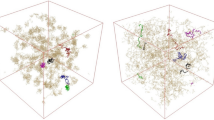Abstract
A REVIEW of recent work in physical, physiological and enzyme chemistry, and crystallography1 yields a rather definite and precise picture of the native protein. In consequence of the widespread phenomenon of the reversible dissociation of native proteins into aliquot parts2, it is necessary to assume that the native proteins, consisting in some cases of molecules in monomeric form—which we shall call protein units to indicate that they cannot dissociate further without losing their protein character—are in many cases particles,, consisting of aggregates of protein units3. The protein unit, it appears, is a rigid atomic framework formed by the interbonding of the skeletal atoms of the residues. In consequence the Ca atoms carrying the amino acid R-groups and the Ca—N atoms holding the imino acid rings form fixed patterns in space. It is, we suggest, the spatial patterns of the N—Ca—C atoms in the skeletons which define the protein character and the allocations of this and that variety of residues to the various positions in these skeletons which define the specific characters of individual units. Such a picture, suggested by data from so many fields, seems definitely required by immuno-chemical findings4, which make it necessary to postulate that the specific R-groups on protein antibodies are held in spatial patterns on the molecular surfaces5. To complete the description of protein particles and protein frameworks in general, it is necessary, in addition, to specify the way in which the individual protein units—which need not be identical—are associated. It is the nature of these associations and the implications regarding the nature of systems of native protein units in general which are the subject of this communication.
Similar content being viewed by others
References
Wrinch, Cold Spring Harbor Symposia, on Quant. Biol., 9, 218 (1941).
Svedberg and Pedersen, "The Ultracentrifuge" (Oxford, 1939).
Wrinch, Cold Spring Harbor Symposia on Quant. Biol., 6, 122 (1938).
Wrinch, NATURE, 137, 411 (1936).
Marrack, "Chemistry of Antigens and Antibodies" (London: H.M. Stationery Office, 1939), 27, 91.
Wrinch, Collecting Net, 16, 121 (1941).
Wrinch, Phil. Mag., 26, 313 (1938); 31, 177 (1941).
Conn, Gregg, Kistiakowsky and Roberts, J. Amer. Chem. Soc., 63, 2080 (1941).
Fankuchen, Ann. New York Acad. Sci., 41, 157 (1941).
Wrinch, Collecting Net, 16, 177 (1941).
Author information
Authors and Affiliations
Rights and permissions
About this article
Cite this article
WRINCH, D. NATIVE PROTEINS, FLEXIBLE FRAMEWORKS AND CYTOPLASMIC ORGANIZATION. Nature 150, 270–271 (1942). https://doi.org/10.1038/150270a0
Issue Date:
DOI: https://doi.org/10.1038/150270a0
- Springer Nature Limited
This article is cited by
-
Growth-Inhibiting Action of Some Pure Substances
Nature (1944)





